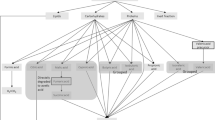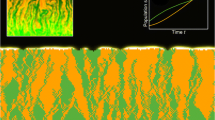Abstract
This article discusses the growth of methanotrophic biofilms. Several independent biofilm growths scenarios involving different inocula were examined. Biofilm growth, substrate removal and product formation were monitored throughout the experiments. Based on the oxygen consumption it was concluded that heterotrophs and nitrifiers co-existed with methanotrophs in the biofilm. Heterotrophic biomass grew on soluble polymers formed by the hydrolysis of dead biomass entrapped in the biofilm. Nitrifier populations developed because of the presence of ammonia in the mineral medium. Based on these experimental results, the computer program AQUASIM was used to develop a biological model involving methanotrophs, heterotrophs and nitrifiers. The modelling of six independent growth experiments showed that stoichiometric and kinetic parameters were within the same order of magnitude. Parameter estimation yielded an average maximum growth rate for methanotrophs, μm, of 1.5 ± 0.5 d−1, at 20 °C, a decay rate, bm, of 0.24 ± 0.1 d−1, a half saturation constant, \({\text{K}}_{{\text{S(CH}}_{\text{4}} {\text{)}}} \), of 0.06 ± 0.05 mg CH4/L, and a yield coefficient, \(Y_{CH_4 } \), of 0.57 ±: 0.04 g X/g CH4. In addition, a sensitivity analysis was performed on this model. It indicated that the most influential parameters were those related to the biofilm (i.e. density; solid-volume fraction; thickness). This suggests that in order to improve the model, further research regarding the biofilm structure and composition is needed.
Similar content being viewed by others
References
Alvarez-Cohen L & McCarty PL (1991) Product toxicity and cometabolic competitive inhibition modelling of chloroform and trichloroethylene transformation by methanotrophic resting cells. Appl. Environ. Microbiol. 57: 1031–1037
APHA (1989) Standard methods for the examination of water and wastewater. 17th edition, American Public Health Association, Washington, D.C.
Anderson JE & McCarty PL (1994) Model for treatment of trichloroethylene by methanotrophic biofilms. J. Envir. Eng. 120: 379–400
Arcangeli JP, Arvin E, Mejlhede M & Lauritsen FR (1996) Biodegradation of cis-1,2-dichloroethylene at low concentrations with methane-oxidising bacteria in a biofilm reactor. Wat. Res. 30: 1885–1893
Arcangeli JP & Arvin E (1997) Modelling of the growth of a methanotrophic biofilm. Wat. Sci. Tech. 36: 199–204
Arvin E (1991) Biodegradation kinetics of chlorinated aliphatic hydrocarbons with methane oxidizing bacteria in an aerobic fixed biofilm reactor. Wat. Res. 25: 873–881
Bédard C & Knowles R (1989) Physiology, biochemistry, and specific inhibitors of CH4, NH4 +, and CO oxidation by methanotrophs and nitrifiers. Microbiol. Rev. 53: 68–84
Bilbo CM, Arvin E, Holst H & Spliid H (1992) Modelling the growth of methane-oxidising bacteria in a fixed biofilm. Wat. Res. 26: 301–309
Bishop PL & Rittmann BE (1995). Modelling heterogeneity in biofilms: report of the discussion session. Wat. Sci. Tech. 32: 263–265
Broholm K, Christensen TH & Jensen BK (1992). Modelling TCE degradation by a mixed culture of methane-oxidizing bacteria. Wat. Res. 26: 1177–1185
Carlsen HN, Joergensen L & Degn H (1991) Inhibition by ammonia of methane utilization in Methylococcus capsulatus. Appl. Microb. Biotech. 35: 124–127
Characklis WG, Bouwer E, Gujer W, Hermanowicz S, Wanner O, Watanabe J & Wilderer P (1989) Modelling of biofilm system. IAWPRC task group, and technical report. Montana State University, Bozeman, MT, USA
Christensen BE & Characklis WG (1990) Physical and chemical properties of biofilms. pp 93–130. In: Characklis WG and KC Marshall (Eds) Biofilms. Wiley, NY
Dubois M, Gilles KA, Hamilton JK, Rebers PA & Smith F (1956) Colorimetric method for determination of sugar and related substance. Analytical chemistry 28: 350–355
Dunfield P & Knowles R (1995) Kinetics of inhibition of methane oxidation by nitrate, nitrite, and ammonium in a Humisol. Appl. Environ. Microbiol 61: 3129–3135
Ferenci T, Ström T & Quayle JR (1975) Oxidation of carbon monoxide and methane by Pseudomonas methanica. J. Gen. Microbiol. 91: 79–91
Hanson RS & Hanson TE (1996) Methanotrophic bacteria. Microbiological review 60: 439–471
Harrison DEF (1973) Studies on the affinity of methanol-and methane-utilising bacteria for their carbon substrates. J. Applied Bacteriol. 36: 301–308
Heijnen JJ & Roels JA (1981) A macroscopic model describing yield and maintenance relationships in aerobic fermentation processes Biotechnol. Bioeng. 23: 739–763
Harwood JH & Pirt SJ (1972) Quantitative aspects of growth of the methane oxidising bacterium Methylococcus capsulatus on methane in shake flask and continuous chemostat culture. J. Applied Bacteriol. 35: 597–607
Henze M, Grady CPL, Gujer W, Marais GvR & Matsuo T (1987) Activated sludge model No 1. IAWPRC Scientific and technical report No 1. London, UK
Henze M, Gujer W, Mino T, Matsuo T, Wentzel MC & Marais GvR (1995) Activated Sludge Model No 2. IAWQ Scientific and technical report No 3. London, UK
Kristensen GH & Jansen JlC (1980) Fixed Film Kinetics. Description of laboratory equipment. Department of Environmental Engineering, Technical University of Denmark
Lauritsen FR (1990) A new membrane inlet for on-line monitoring of dissolved, volatile organic compounds with mass spectrometry. International Journal of Mass Spectrometry and Ion Processes 95: 259–268
Loosdrecht MCM, Eikelboom D, Gjaltema A, Mulder A, Tijhuis L & Heijnen JJ (1996) Biofilm structures. Wat. Sci. Tech. 32: 35–45
Lowry OH, Rosebrough NJ, Farr AL & Randall RJ (1951) Protein measurement with the folin phenol reagent. J. Biol. Chem. 193: 265–275
McCarty PL (1972) Energetics of organic matter degradation. In: Mitchell R (Ed) Water pollution microbiology. Wiley-Interscience, New York, 99 91–118.
Mejlhede M (1993) Biodegradation of cis-and trans-1,2-dichloroethylene with methane-oxidizing bacteria in a biofilm reactor. M.Sc. thesis. Department of Environmental Science and Engineering The technical University of Denmark (in Danish)
Morigana Y, Yamanaka S, Yoshimura M, Takinami K & Hirose Y (1979) Methane metabolism of the obligate methane-utilising bacterium, methylomonas flagellata, in methane-limited and oxygen-limited chemostat culture. Agric. Biol. Chem. 12: 2453–2458
Norland S, Heldal M & Tumyr O (1987) On the relation between dry matter and volume bacteria. Microb. ecol. 13: 95–101
Ojima DS, Valentine DW, Mosier AR, Parton WJ & Schimel DS (1993) Effect of land use change of methane oxidation in temperate forests and grassland soils. Chemosphere 26: 675–685
Oldenhuis R, Oedzes JY, Van der Waarde JJ & Janssen DB (1991) Kinetics of chlorinated hydrocarbon degradation by Methylosinus trichosporium OB3b and toxicity of trichloroethylene. Appl. Environ. Microbiol. 57: 7–14
Pedersen AR (1991) Growth kinetic of a methane-oxidizing biofilm. M.Sc. thesis Department of Environmental Science and Engineering The technical University of Denmark (in Danish)
Perry RH & Green D (1987) Perry's Chemical engineer handbook 6th edition. McGraw-Hill International edition.
Reichert P (1994) AQUASIM — a tool for simulation and data analysis of aquatic systems. Wat. Sci. Technol. 30: 21–30
Stanier RY, Ingraham JL, Wheelis ML & Painter PR (1987) General Microbiology. 5th edition. Prentice-Hall, New Jersey
Tsien HC, Brusseau GA, Hanson RS & Wackett LP (1989) Biodegradation of trichloroethylene by Methylosinus trichosporium OB3b. Appl. Environ. Microbiol. 55: 3155–3161
Wanner O Reichert P (1996) Mathematical modelling of mixed-culture biofilms. Biotechnol. Bioeng. 49: 172–184
Whittenbury R, Phillips KC & Wilkinson JF (1970) Enrichment, isolation and some properties of methane-utilising bacteria. J. Gen. Microbiol. 61: 205–218
Wilkinson TG & Harrison DEF (1973) The affinity of methane and methanol of mixed culture grown on methane in continuous culture. J. Appl. Bacteriol. 36: 309–313
Wilkinson TG, Topiwala HH & Hamer G (1974) Interactions in mixed bacterial population growing on methane in continuous culture. Biotechnol. Bioeng. 16: 41–59
Wilson JT & Wilson BH (1985) Biodegradation of trichloroethylene in soil. Appl. Environ. Microbiol. 49: 242–243
Author information
Authors and Affiliations
Rights and permissions
About this article
Cite this article
Arcangeli, JP., Arvin, E. Modelling the growth of a methanotrophic biofilm: Estimation of parameters and variability. Biodegradation 10, 177–191 (1999). https://doi.org/10.1023/A:1008317906069
Issue Date:
DOI: https://doi.org/10.1023/A:1008317906069




